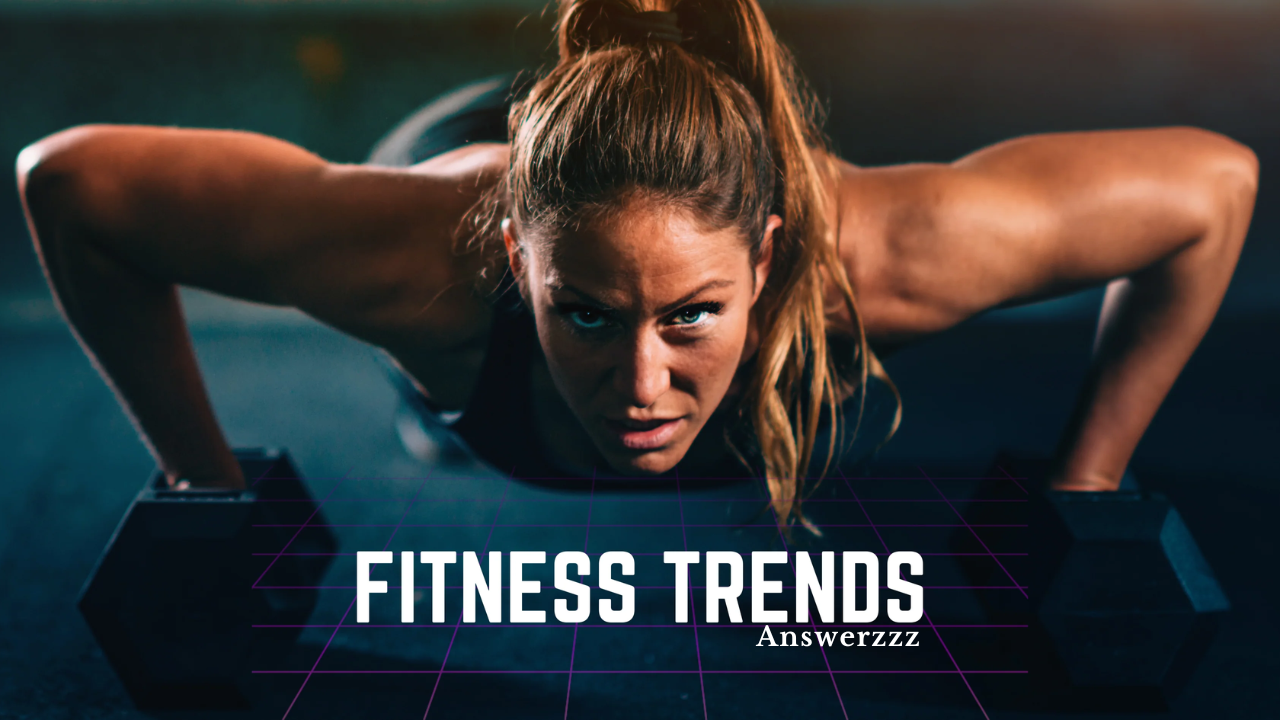The world of fitness and wellness has continued to evolve at a rapid pace, and 2025 is set to be no exception. As people’s understanding of health deepens and technology continues to influence every aspect of life, the fitness industry is embracing innovative workout methods, holistic wellness programs, and the fusion of physical and mental well-being. Whether you’re a fitness enthusiast or someone looking to start your health journey, 2025 promises a diverse range of trends that will cater to all types of individuals.
This article explores the top fitness and wellness trends expected to dominate in 2025, from cutting-edge workout routines to personalized wellness programs, all aimed at promoting a balanced and healthier lifestyle.
1. Hybrid Fitness: Combining the Best of In-Person and Virtual Workouts

The hybrid fitness model, which emerged in response to the global pandemic, continues to gain traction in 2025. This trend offers a blend of both in-person and virtual fitness experiences, giving individuals more flexibility in how they stay active. With many people leading busy lives, the ability to attend a workout class from the comfort of home or at the gym is a game-changer.
In 2025, expect to see more gyms and fitness studios offering hybrid memberships that provide access to live-streamed classes, on-demand workout videos, and in-person sessions. These programs often feature interactive components, such as virtual trainers who provide real-time feedback or encourage participants to stay on track with their goals.
Hybrid fitness also allows for a greater sense of community. Through virtual challenges, leaderboards, and social platforms, participants can connect with others, making fitness not just a solitary activity but a shared experience.
Benefits of Hybrid Fitness:
- Flexibility to exercise anytime, anywhere
- Access to top trainers and workout programs globally
- Personalized experiences tailored to individual fitness levels
2. Wearable Technology and Data-Driven Workouts
Wearable technology continues to evolve, and in 2025, it plays a central role in how people approach fitness. From fitness trackers to smartwatches, wearables have become more sophisticated, allowing users to monitor their performance with greater accuracy. These devices now track everything from heart rate variability to sleep patterns and stress levels, giving users a comprehensive view of their overall health.
One key trend for 2025 is the integration of Artificial Intelligence (AI) in wearable devices. AI-driven platforms analyze real-time data and provide personalized workout plans based on an individual’s current fitness levels, goals, and even the weather. For example, AI could suggest low-impact indoor workouts on a rainy day or recommend recovery exercises after intense training sessions.
Wearable devices also make it easier to track progress and adjust fitness routines accordingly, motivating users to stay consistent. These tools not only focus on physical performance but also mental well-being, tracking things like mindfulness minutes and offering breathing exercises to reduce stress.
Popular Wearables in 2025:
- Smart rings and bands for non-intrusive tracking
- AI-driven apps for personalized workout recommendations
- Advanced fitness trackers with long battery life and waterproof features
3. Functional Fitness for Longevity
As the population ages and people increasingly prioritize long-term health, functional fitness is becoming a key trend in 2025. This type of workout focuses on movements that enhance everyday activities, helping individuals improve their strength, balance, flexibility, and coordination. The goal of functional fitness is not just to build muscle but to promote better mobility, injury prevention, and overall physical resilience.
Workouts in this category often mimic real-life actions such as lifting, squatting, pushing, and pulling, which can improve an individual’s ability to perform day-to-day tasks with ease. Functional fitness programs are especially beneficial for older adults or those recovering from injuries, as they emphasize low-impact exercises that strengthen muscles and joints.
In 2025, expect to see more fitness centres offering classes that focus on functional movements, bodyweight exercises, and the use of equipment like resistance bands, kettlebells, and stability balls. These workouts are suitable for all ages and fitness levels, and they provide a sustainable way to stay active for years to come.
Key Functional Fitness Exercises:
- Squats and lunges for leg and core strength
- Push-ups and pull-ups for upper-body conditioning
- Planks and balancing exercises to improve stability
4. Mental Health and Fitness Fusion
In 2025, mental health is no longer an afterthought in fitness; it is a central component. The fusion of physical fitness and mental well-being is shaping how people approach their workouts. Recognizing that emotional and psychological health are just as important as physical fitness, more programs now focus on holistic wellness.

Mindfulness practices, such as meditation, deep breathing exercises, and yoga, are being integrated into workout routines to help individuals manage stress and improve their mental clarity. These programs are designed to not only build physical strength but also foster resilience, enhance emotional stability, and promote better mental health.
Fitness apps and wellness platforms are increasingly incorporating mental health tracking tools, offering features like daily mood checks, guided mindfulness sessions, and access to mental health resources. Additionally, the rise of “mental fitness” programs emphasizes cognitive exercises, such as problem-solving and creativity-enhancing activities, aimed at keeping the mind sharp and healthy.
Ways Fitness and Mental Health Intersect:
- Guided yoga and meditation classes focused on stress relief
- Workout routines that incorporate mindfulness and breathing exercises
- Cognitive training apps to boost mental agility
5. High-Intensity Interval Training (HIIT) 2.0
High-Intensity Interval Training (HIIT) has been a popular workout trend for years, but in 2025, it will evolve into a more structured and personalized format. HIIT 2.0 takes the core principles of interval training—short bursts of intense exercise followed by periods of rest—and tailors them to individual fitness levels and goals.
AI-powered fitness apps are leading the way in this trend, offering HIIT programs that adjust in real time based on the user’s heart rate, fatigue levels, and progress. These smart programs ensure that individuals are pushing themselves to the right intensity without overtraining, allowing for safer and more effective workouts.
Additionally, there is a growing focus on incorporating recovery and mobility work into HIIT routines, making the workouts more balanced and less taxing on the body. This helps prevent injuries and ensures that individuals can maintain their fitness levels over the long term.
Key Features of HIIT 2.0:
- AI-guided intervals for optimal performance
- Integration of recovery exercises between intense sets
- Personalized intensity levels based on real-time data
6. Group Workouts and Community Building
Fitness is becoming a more social activity in 2025, as people seek to connect with others and build a sense of community. Group workouts, whether in-person or virtual, are on the rise as they provide motivation, accountability, and a shared sense of purpose. These classes range from traditional group fitness sessions like cycling and Zumba to more innovative formats such as dance-based workouts and team-based fitness challenges.
Fitness platforms are increasingly incorporating social features, such as live leaderboards, group challenges, and social media integration, to create a more engaging and supportive environment for participants. Whether it’s a local gym class or a global fitness challenge, people are finding new ways to connect, compete, and collaborate.
Community-driven fitness programs help individuals stay consistent with their workouts and create lasting bonds with like-minded people. This trend taps into the social nature of human beings, turning fitness into not just a personal journey but a shared experience.
Examples of Popular Group Fitness Trends:
- Virtual and in-person team challenges
- Dance-based workouts that combine fitness with fun
- CrossFit and boot camp-style group sessions
7. Wellness Retreats and Fitness Travel
As more people prioritize their health and well-being, wellness retreats and fitness travel are booming in 2025. These retreats offer a holistic approach to wellness, combining physical fitness, mental health, and relaxation in beautiful, serene settings. Whether it’s a weekend getaway focused on yoga and meditation or a full-blown fitness boot camp in a tropical destination, wellness travel provides an opportunity to escape the daily grind and focus on personal health.

Wellness retreats are often designed to offer a break from technology and everyday stress, with activities that range from guided hikes and outdoor workouts to nutrition workshops and spa treatments. This trend appeals to individuals looking for a comprehensive approach to health that goes beyond a typical gym session.
In 2025, fitness travel also includes adventure-based programs that allow participants to engage in activities such as surfing, rock climbing, or trekking. These programs not only promote physical activity but also offer unique experiences that nurture mental and emotional well-being.
Types of Wellness Retreats:
- Yoga and meditation retreats in natural settings
- Adventure-based fitness programs like hiking and surfing
- Luxury wellness resorts with a focus on nutrition and relaxation
8. Personalized Nutrition and Fitness Plans
In 2025, personalization is at the core of fitness and wellness programs. Thanks to advancements in technology and data analysis, individuals can now receive highly customized workout plans and nutrition guidance tailored to their unique needs. Whether through DNA testing, metabolic analysis, or AI-driven health platforms, personalized fitness and nutrition are revolutionizing how people approach their health.
Personalized nutrition programs take into account factors such as an individual’s genetic makeup, lifestyle, food preferences, and fitness goals. These programs often recommend specific diets, supplements, and meal plans designed to optimize energy levels, improve performance, and enhance overall well-being.
Similarly, personalized workout plans are designed based on an individual’s physical capabilities, health history, and personal goals. Fitness apps and wearable devices analyze data in real time and adjust training programs to ensure maximum efficiency and safety.
Advantages of Personalized Fitness and Nutrition:
- Tailored programs that cater to individual needs and goals
- More effective and efficient results due to customized plans
- Integration of genetic, metabolic, and lifestyle data for holistic health management
The fitness trends of 2025 reflect a growing desire for flexibility, personalization, and a holistic approach to health and well-being. From hybrid fitness models to personalized nutrition plans and the fusion of mental and physical health, these trends cater to the evolving needs of individuals in a fast-paced, technology-driven world. Whether you’re looking to build strength, improve mental health, or simply enjoy a healthier lifestyle, the innovations in 2025 will provide the tools and programs to help you reach your goals. Fitness is no longer just about aesthetics—it’s about achieving balance, longevity, and overall well-being.



